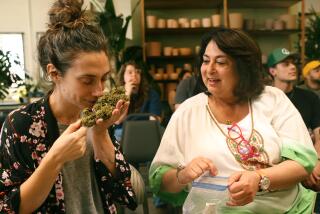Circle of Life
Unless they’re plastic, most wreaths will dry, become brown and some even become a fire hazard.
The short-lived nature of this otherwise beautiful decoration led horticulturist Teddy Colbert to create living wreaths.
Made from wire, sphagnum moss and soil, these wreaths hold live plants that continue to grow. A well-constructed one can last for years.
“I have a succulent wreath outdoors that is still growing strong after 16 years,” said Colbert, author of “The Living Wreath” (Gibbs-Smith Publisher, $19.95). She runs Teddy Colbert’s Garden in Somis, a Ventura County mail-order company that offers living wreaths and supplies for creating them.
Sustaining plants in a small space makes these wreaths appealing.
“Many gardeners have limited gardening space, but they want something satisfying and interesting and the living wreath gives them that,” Colbert said. “It’s essentially a miniature garden.”
Wreaths have been around for centuries. That they create an unending circle has held significance for a variety of cultures. In ancient Greece, lovers hung wreaths on their doorways to show acceptance of one another. Romans used wreath crowns of laurel, oak and myrtle to salute military victors and athletes.
*
A living wreath has a variety of uses.
“You can leave the wreath laying down and use it for candles throughout the year, or hang it on a wall, garden gate or doorway,” Colbert said. “Living wreaths made from lettuce and other greens can be used as an edible centerpiece for buffets. And herb wreaths are beautiful and useful when hung near the kitchen door.”
The living wreath is also a good gift, said Darrelyn Mayernik of Fullerton, who is co-chair of the Fullerton Arboretum Potters. “They last rather than fading and becoming crispy,” she said.
The arboretum sells succulent candleholder wreaths during its holiday plant sales from 10 a.m. to 4 p.m. Saturdays and Sundays.
Colbert sells constructed wreaths and ready-to-plant wreath bases.
Completed wreaths are not inexpensive. A medium succulent wreath with four candleholders costs $225.
As an alternative, you can buy a frame kit for $40, and add plants, moss and soil. Colbert also has instructions in her book on how to create a wreath from frames sold at craft stores.
Here are some general tips for creating and caring for living wreaths:
* Wreath type. A living wreath can be made from succulents, herbs, flowers (bacopa, impatiens, petunia and alyssum), lettuce and other greens, small vegetables (cherry tomatoes and green onions), fruits (alpine strawberries), edible flowers (nasturtiums and violas) and alfalfa sprouts.
Succulent wreaths are long-lasting and don’t require much replanting. Other wreath types, such as lettuce and greens, will need to be replanted every three or four months.
Good succulent choices for a living wreath include crassula, sedum, kalanchoe, echeveria and miniature jade.
You need rooted plants for most wreath types, except for succulents, which do best as cuttings. You can get succulent cuttings from your yard or through mail-order companies. Before planting the cuttings, wait for them to “heal over,” which means leaving them in a well-ventilated area away from direct sunlight until the cutting forms a hard callus.
* Moss matters. Soak sphagnum moss thoroughly before planting. If the moss is dry and surface tension prevents absorption, Colbert suggests adding one drop per gallon of liquid dish soap to hasten the process. Drain the moss for a few hours or overnight before using.
Whenever you handle wet sphagnum, make sure to use surgical gloves, as moisture activates a harmful fungus in the moss.
* Creating candleholders. Good, low-mounding plant choices for candleholders are Echeveria, haworthia and bedstraw. For suspended wreaths use donkey tail, string of hearts, string of pearls, Mildred’s mystery and Othonna capensis on the outer sides as these tend to cascade. Kalanchoe pumila is also a good choice because it cascades and its silver leaves reflect the light of the candles.
Protect candelabra plants from dripping wax with a small, flat, doughnut-shaped piece of glass or disk shaped out of a foil pie plate. Also protect tables and other surfaces from the wreath by placing a piece of glass or plastic underneath it.
* Plant positions. Don’t corral plants in rows. “I have seen some arrangements that resemble bull’s-eye targets,” Colbert said. “Healthy growing plants, even with heavy pruning, soon defy those boundaries.”
Group smaller plants as they grow in nature, tucking them under larger specimens. Add delicate plants as final touches to avoid their being damaged.
* Protecting plants. Secure a short-stemmed or heavy cutting with a hairpin by straddling the cutting. Never stick the pin into the flesh of the stem or leaf.
Allow hanging wreaths a recovery period in a horizontal position so that the roots will have a chance to take hold.
Protect wreaths from frost, drying winds and hot, intense sun.
* Sun exposure. Provide adequate light. High light is generally a requirement for succulent wreaths, with protection from midday sun in intense heat. Impatiens wreaths will require shade, lettuce wreaths can take part shade and herbs need sun.
* Water properly. In general, dunking your plant in water is better than dribbling or dripping it with water. Submerge the wreath in a slightly larger container than the wreath’s full size until bubbles stop coming to the surface. Drain immediately.
When dunking isn’t possible, water your wreath with a slow dribble from the hose or use drip irrigation. Make sure the the wreath is thoroughly wetted.
Protect succulent wreaths from excessive rain, which can eventually rot the plants.
* Moisture and fertilizer. Growing crops such as strawberries and lettuce means adding more moisture and food than succulents. Add water-retaining soil polymers such as Broadleaf P-4 to the soil and use time-released fertilizer.
To encourage a continuous harvest, Colbert also suggests adding a dilute solution of fertilizer to every watering.
Resources
* Teddy Colbert’s Garden, (800) 833-3981; https://www.livingwreath.com.
* The Fullerton Arboretum, 1900 Associated Road, Fullerton. (714) 278-3579.






